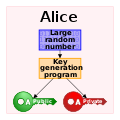Public-key cryptography
Public-key cryptography, also called asymmetric cryptography, is a communication where people send messages that can only be read by those who have the key.
A Metaphor
This kind of cryptography is like two magical paper shredders. Each can shred messages that only the other can unshred.
Explanation
In public key cryptography, each user has a pair of cryptographic keys, which are long strings of random data. One of the keys is public, and can be shared with anyone, even bad actors. One of the keys is private, and must be kept secret. Information encrypted with the public key can be decrypted with the private key, and vice versa.
Incoming messages are encrypted with the recipient's public key and can only be decrypted with their corresponding private key. The keys are related mathematically, but it is nearly impossible to get a private key from a public key.
The two main branches of public key cryptography are:
- Public key encryption: a message encrypted with a recipient's public key cannot be decrypted except by the recipient private key. This is used to ensure secrecy.
- Digital signatures: a message signed with a sender's private key can be verified by anyone who has the sender's public key. So if the sender signed the message no one can alter it. This is used to ensure authenticity.
They are often used together on the same message.
Public-key Cryptography Media
In this example the message is digitally signed with Alice's private key, but the message itself is not encrypted.*1) Alice signs a message with her private key.*2) Using Alice's public key, Bob can verify that Alice sent the message and that the message has not been modified.
In the Diffie–Hellman key exchange scheme, each party generates a public/private key pair and distributes the public key of the pair. After obtaining an authentic (n.b., this is critical) copy of each other's public keys, Alice and Bob can compute a shared secret offline. The shared secret can be used, for instance, as the key for a symmetric cipher.



